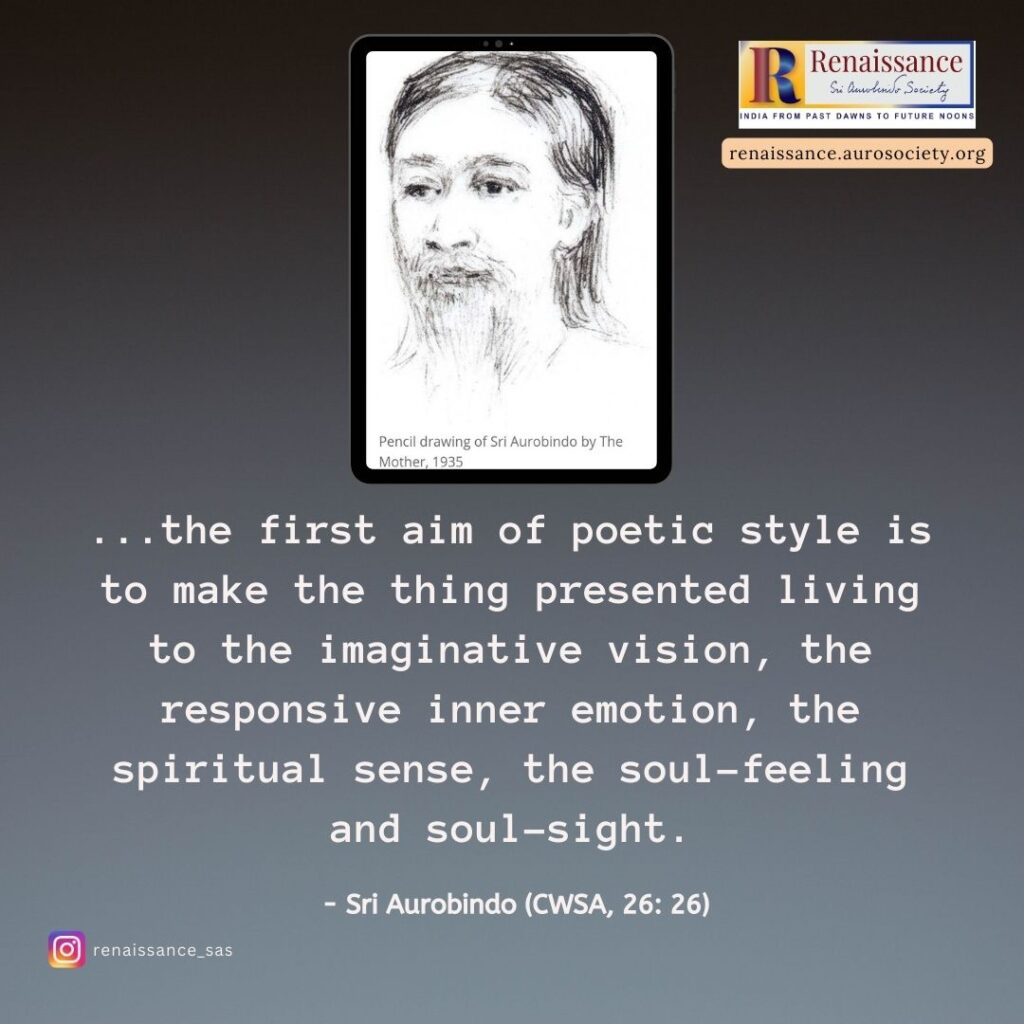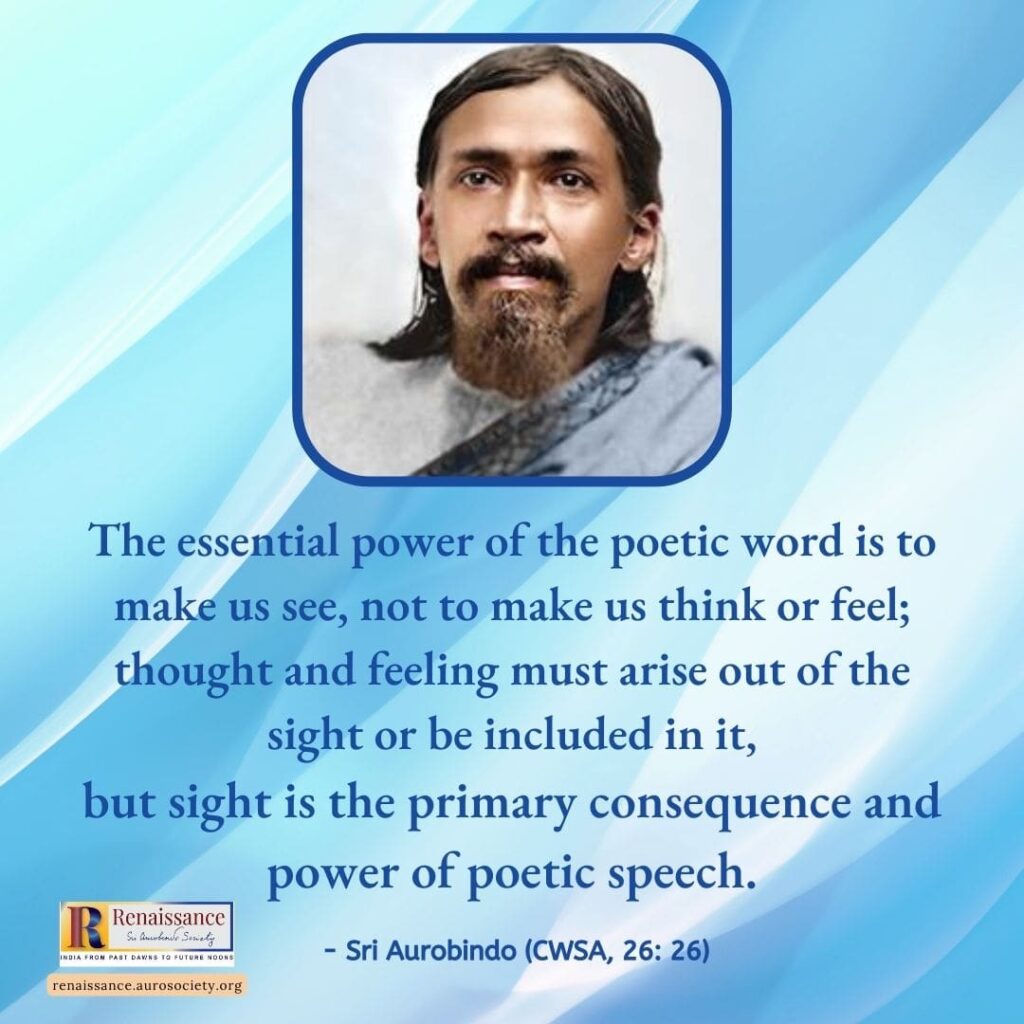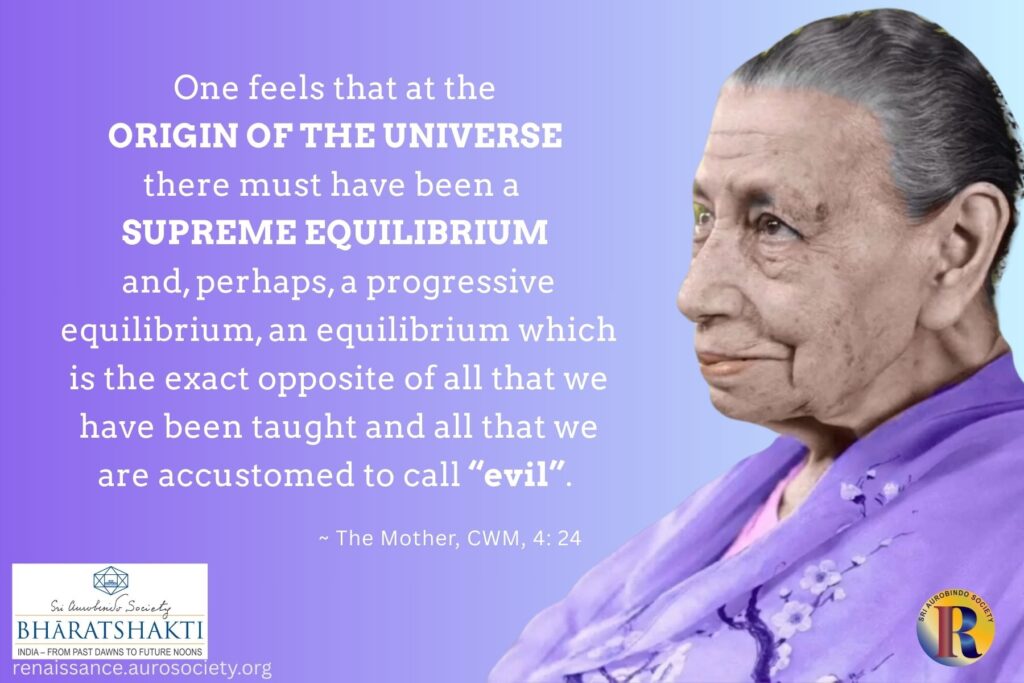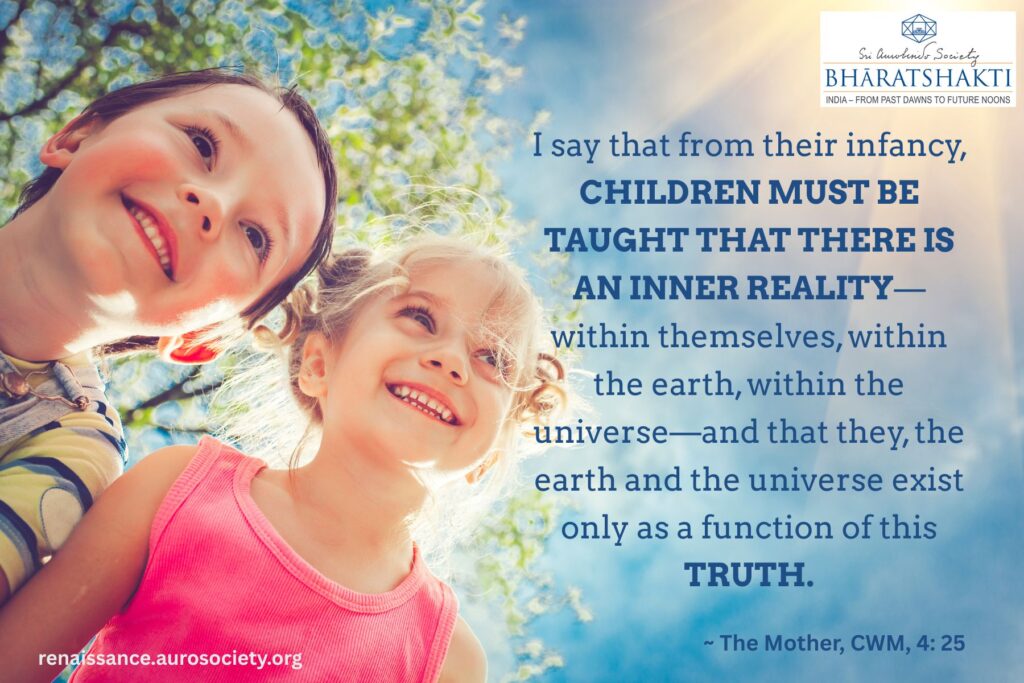Editor’s note: In this two-part essay, the author, a poet herself presents a few key facets of Sri Aurobindo’s poetry and poetics which she finds most fascinating. In this first part, the focus is on poetry as an expression of spiritual experience, and also on Sri Aurobindo, the poet-maker.

PART 1
For neither the intelligence, the imagination nor the ear are the true or at least the deepest or highest recipients of the poetic delight, even as they are not its true or highest creators; they are only its channels and instruments: the true creator, the true hearer is the soul. . . . Therefore poetry has not really done its work, at least its highest work, until it has raised the pleasure of the instrument and transmuted it into the deeper delight of the soul.
~ Sri Aurobindo, CWSA, Vol. 26, p. 10
Sri Aurobindo’s ‘Rose of God’ is a poem that adeptly illustrates this point.
Rose of God, vermilion stain on the sapphires of heaven,
Rose of Bliss, fire-sweet, seven-tinged with the ecstasies seven!
Leap up in our heart of humanhood, O miracle, O flame,
Passion-flower of the Nameless, bud of the mystical Name.
Rose of God, great wisdom-bloom on the summits of being,
Rose of Light, immaculate core of the ultimate seeing!
Live in the mind of our earthhood; O golden Mystery, flower,
Sun on the head of the Timeless, guest of the marvellous Hour.
Rose of God, damask force of Infinity, red icon of might,
Rose of Power with thy diamond halo piercing the night!
Ablaze in the will of the mortal, design the wonder of thy plan,
Image of Immortality, outbreak of the Godhead in man.
– CWSA, Vol. 2, p. 546 (first three stanzas)
Approaching the subject of Sri Aurobindo’s poetry is akin to finding oneself scouring an ever-expanding universe; for there is so much to consider. The literary corpus of Sri Aurobindo available to us encompasses more than 4,000 pages of poetry, plays, translations, poetics, literary criticism, prospects of future poetry, letters on poetry and of course two mighty epics, Ilion composed in quantitative hexameter and the iconic Savitri in blank verse iambic pentameter.
The volume titled Collected Poems — belonging to numerous genres of poetry — alone runs into 750 pages, and the epic Savitri is 725 pages of poetic creation. We could also add prose translations of the verses of the Rig Veda, the Upanishads and the Gita, these trans-creations with their rhythm of the most euphonic poetry.
I present here a few key facets of Sri Aurobindo’s poetry and poetics which I find most fascinating. I especially highlight how coming to Sri Aurobindo gave my poetry a new direction, for which I am eternally grateful.

Formative Years that Shaped Sri Aurobindo, the Poet
While most readers may already be familiar with it, it is still helpful to begin with a brief look at the formative years which shaped Sri Aurobindo, the Poet. Born in Kolkata in 1872 to Swarnalata Devi and Dr. K.D. Ghose, Aravinda Akroyd Ghose received a complete English education. Dr. Ghose had lived in Britain and had studied at Aberdeen University, was determined that his children should have a completely European upbringing. He sent Aurobindo and his siblings to Loreto Convent School at Darjeeling.
At the age of seven, Aurobindo was taken along with his two elder brothers, Manmohan and Benoybhusan, to England. There, they were placed with a clergyman and his wife, a Mr. and Mrs. Drewett, at Manchester, who tutored Aurobindo privately. Mr. Drewett, himself a capable scholar, grounded Aurobindo so well in Latin that Aurobindo was able to gain admission into St Paul’s School in London. At St. Paul’s, Sri Aurobindo mastered Greek and excelled at Latin.
The last three years at St Paul’s were spent in reading, especially English Poetry.
At St. Paul’s he received the Butterworth Prize for literature, the Bedford Prize for history and a scholarship to Cambridge University. He returned to India in 1893. Not once during the entire period did young Aurobindo come in contact with the traditional Indian life or culture.
At the same time, in England, he never was taught English as a separate subject but picked it up like a native in daily conversation. Before long he was spending much of his time reading. Almost from the start, he devoted himself to serious literature. As a ten-year-old, he read the King James Bible.
Soon this brilliant student mastered half a dozen European languages, including Greek and Latin in which he scored the highest marks ever obtained in a school examination. The classical European literature which he mastered, later found effective expression in his poetic writings, for instance in Perseus the Deliverer as a play and Ilion as an epic in Homeric quantitative hexameter based on the naturalness of temperament of the English language.
ALSO READ:
Life, Love and Union in Sri Aurobindo’s Eric
Sri Aurobindo, the Poet-maker
During the 1930s, until around November 1938, Sri Aurobindo ran what academically can be called the Ashram’s Department of Poetry. Young and enthusiastic disciple-poets took lessons in poetry under him.
Some of the ‘Department’s’ disciple–‘students’ were, Arjava, Amal Kiran, Dilip Kumar Roy, Harindranath Chattopadhyaya, Nishikanto, Nirodbaran, Jyotipriya and Nolini Kanta Gupta. They would send their poems to Sri Aurobindo, and he would guide them with his detailed comments and suggestions. He offered input on a certain turn of the phrase, imagery, rhythm, style, concepts, highlighting lines which were significant, including their sources of inspiration and new possibilities of expression.
He also made an elaborate attempt in bringing out the essential and necessary character of writings moving towards the utterance of the “inspired and inevitable” kind. Voluminous literature has grown around this correspondence between Sri Aurobindo and his poet-disciples, running in thousands of letters, notes, comments. It is in them that we first find the new phrase, what Sri Aurobindo calls the ‘Overhead Poetry.’ (I elaborate upon this in a separate section in this essay).
When the flood-gates are swung wide,
Where shall hide all the evil ones now so cosily lodged?
The surging luminosities shall hurl themselves scouring and flooding
And force each nook and corner, rush each bend and turn
And sweep all that cleaves and clogs, all that obscures and is obscure!
An ocean of Light shall I become,
A thousand rivers of light flowing into it and rising out of it —
Light playing with light, light woven into light —
A solar world made of the glories of the gods!
– Nolini Kanta Gupta, ‘To the Heights’

My Introduction to Sri Aurobindo’s Poetry
When I moved to Pondicherry more than eight years ago, my poetic journey took a surprisingly new direction under the same guidance of the Master, for which I am eternally grateful.
I have been writing poetry since I was 19 or younger. Later when I moved to Mumbai to pursue a career in journalism in the 80’s, I found myself drawn into the then dynamic world of Indian poets writing in English.
In the absence of social media and the presence of a large number of (digital) poetry magazines, the one I founded (The Brown Critique) became instantaneously popular among the poets’ fraternity across the country. Apart from publishing hundreds of poets in my journal, I have been publishing my poems and prose in major Indian and international journals.
My first major introduction to Sri Aurobindo was via poetry.
Sushanto, one of the sadhaks at Sri Aurobindo Ashram and an accomplished artist, ran a weekly poetry ‘class’ (and still does) at the Society Hall in Pondicherry. My then colleague and friend, Rucha, introduced me to it.
It took me less than a minute to be able to connect and comprehend Sri Aurobindo’s poems; the magic was palpable. Since then, I have read his work extensively. But it is his poetry, which shifts my perspective in a significant way with its illumination and highest intensities and beauty every time I read any of his poems.
I continue to have deep regard and respect for the work of a large number of Indian poets writing in English, both established and the burgeoning ones, many of who are my lifelong friends. The richness of their work and what many Indian poets have accomplished is admirable. It is indeed a huge honour and privilege for me to be recognized by them and be an intrinsic part of this community.
I feel I have arrived at a point in my life where I honestly wonder if ‘spiritual’ poetry can be segregated from the ‘non-spiritual.’
In fact, many are of the belief that all poetry is spiritual. I have found that reading Pulitzer prize winning poet Theodore Roethke’s ‘Waking’ can indeed be an intense spiritual experience:
I wake to sleep, and take my waking slow.
I feel my fate in what I cannot fear.
I learn by going where I have to go.
We think by feeling. What is there to know?
I hear my being dance from ear to ear.
I wake to sleep, and take my waking slow.
Of those so close beside me, which are you?
God bless the Ground! I shall walk softly there,
And learn by going where I have to go.
Light takes the Tree; but who can tell us how?
The lowly worm climbs up a winding stair;
I wake to sleep, and take my waking slow.
What Makes Sri Aurobindo’s Poetry Stand Out?
When a disciple asked Sri Aurobindo about his poems written during the 1930s, “could you tell me what your object is in manifesting something through the form of poetry?“, he replied:
I am expressing spiritual truth or spiritual experience through poetry.
~ CWSA, Vol. 27, p. 260
Sri Aurobindo worked diligently and tirelessly to express the vision of his truth via myriad genres.
To appreciate the true essence of the spiritual and mystic character of Sri Aurobindo’s poetry, let us consider the following written in a letter to Dilip Kumar Roy. Here he explains the nature of the concrete experience of the Divine:
Now, certainly, the Divine must be such a certitude not only as concrete but more concrete than anything sensed by ear or eye or touch in the world of Matter; but it is a certitude not of mental thought but of essential experience.
~ Sri Aurobindo, CWSA, Vol. 28, pp. 338-339
When the Peace of God descends on you, when the Divine Presence is there within you, when the Ananda rushes on you like a sea, when you are driven like a leaf before the wind by the breath of the Divine Force, when Love flows out from you on all creation, when Divine Knowledge floods you with a Light which illumines and transforms in a moment all that was before dark, sorrowful and obscure, when all that is becomes part of the One Reality, when the Reality is all around you, you feel at once by the spiritual contact, by the inner vision, by the illumined and seeing thought, by the vital sensation and even by the very physical sense, everywhere you see, hear, touch only the Divine.
Then you can much less doubt it or deny it than you can deny or doubt daylight or air or the sun in heaven—for of these physical things you cannot be sure that they are what your senses represent them to be; but in the concrete experience of the Divine, doubt is impossible.
In the poem ‘Transformation’ Sri Aurobindo admits,
I am no more a vassal of the flesh
A slave to nature and her laden rule
I am caught no more in the senses, narrow mesh,
My soul unhorizoned widens to measureless sight
My soul is God’s happy living tool,
My spirit a vast sum of deathless light.
One is reminded of Sri Aurobindo’s words from The Future Poetry where he speaks of a true poetic utterance as “not merely a godlike pastime; but a great formative and illuminative power.” (CWSA, Vol. 26, p. 12)

Sri Aurobindo uses a variety of styles—dramatic, romantic and narrative when occasion needs.
We observe that in thought and philosophy, Sri Aurobindo was a true Indian. But he used both Indian and Western narratives and references successfully. Drawing inspiration from the Vedic writings, Sri Aurobindo lays great emphasis on poetic diction and rhythm:
The importance of metre arises from the fact that different arrangements of sound have different spiritual and emotional values, . . . In these different arrangements of syllabic sound metre forms the most important, at least the most tangible element. . .
~ CWSA, Vol. 1, pp. 242-243
Inspiration itself seems hardly so much a matter of ideas or feeling as of rhythm. Even when the ideas or the feelings are active, they will not usually run into the right form, the words will not take their right places, the syllables will not fall into a natural harmony.
But if one has or succeeds in awaking the right metrical mood, if the metrical form instead of being deliberately created, creates itself or becomes, a magical felicity of thought, diction & harmony attends it & seems even to be created by it. Ideas & words come rapidly & almost as rapidly take their right places as in a well ordered assembly where everyone knows his seat. When the metre comes right, everything else comes right. . .
CONTINUED IN PART 2
~ Design: Beloo Mehra



